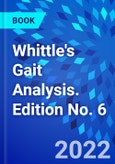This readable textbook offers a clear and accessible guide to the diagnosis and treatment of patients suffering from medical conditions that affect the way they walk.
The book describes both normal and pathological gait and covers the range of simple and complex methods available to perform gait analysis. It will help the reader differentiate the gait cycle phases and pathological gait patterns, identify related factors, and direct therapy precisely.
Now in its sixth edition, Whittle's Gait Analysis has been fully updated by a small team of expert contributors to include the latest thinking on methods of gait analysis and its role in the clinic, making it an ideal text for undergraduate students through to practising allied health professionals.
- Highly accessible, readable, and logically sequenced - suitable for undergraduates
- Covers gait and clinical considerations around functional difficulties in people with neurological and musculoskeletal disorders
- Summary/study aid boxes to support learning
- Online resources containing supplementary content for Chapter 1, video clips, 3D animations, gait data supported by MCQs, and 30 cases studies
- Chapter on running gait, including the biomechanics of running, common running-related injuries, and clinical considerations
- Expanded chapter on neurological conditions
Table of Contents
TBC - draft below:Chapter 1 Basic Sciences
Anatomy
Physiology
Motor control
Biomechanics
Chapter 2 Normal Gait
Walking and gait
History
Terminology used in gait analysis
Outline of the gait cycle
The gait cycle in detail
Ground reaction forces
Support moment
Energy consumption
Optimization of energy usage
Starting and stopping
Other varieties of gait
Changes in Gait with Age
Chapter 3 Pathological and other abnormal gaits
Specific gait abnormalities
Walking aids
Treadmill gait
Chapter 4 Methods of gait analysis
Visual gait analysis
Temporal and Spatial Parameters during Gait
Measurement of Temporal and Spatial Parameters during Gait
Camera Based Motion Analysis
Active marker systems
Accelerometers
Gyroscopes, Magnetic Fields and Motion Capture Suits
Measuring Force and Pressure
Pressure beneath the foot
Measuring Muscle Activity
Measuring Energy Expenditure
Combined kinetic/kinematic systems
Chapter 5 Applications of gait analysis
Clinical gait assessment
Conditions benefiting from gait assessment
Future developments
Conclusion
Chapter 6 Gait assessment of neurological diseases
Gait assessment in Cerebral palsy
Gait assessment in Stroke
Gait assessment in Parkinson's disease
Gait assessment in Muscular dystrophy
Chapter 7 Gait analysis in musculoskeletal conditions and prosthetics and orthotics
Total hip replacement
Gait analysis in knee osteoarthritis
High tibial knee osteotomy
Prosthetics and orthotics
Amputee gait
Orthotic gait
NEW Chapter 8 Running gait








